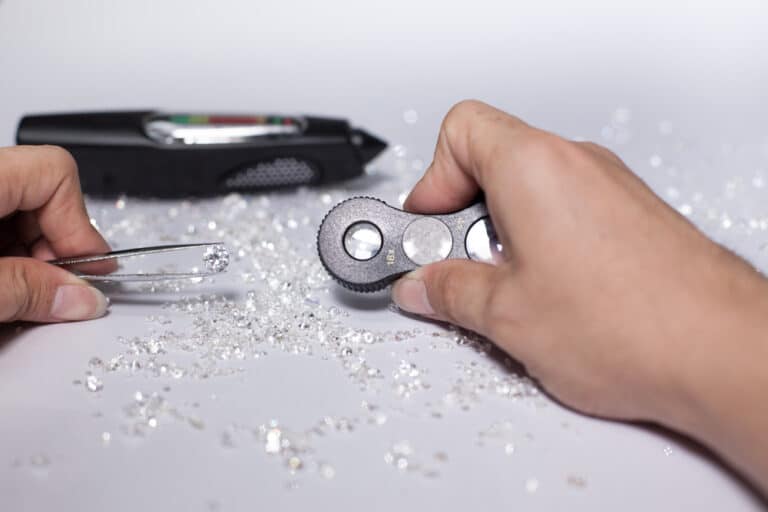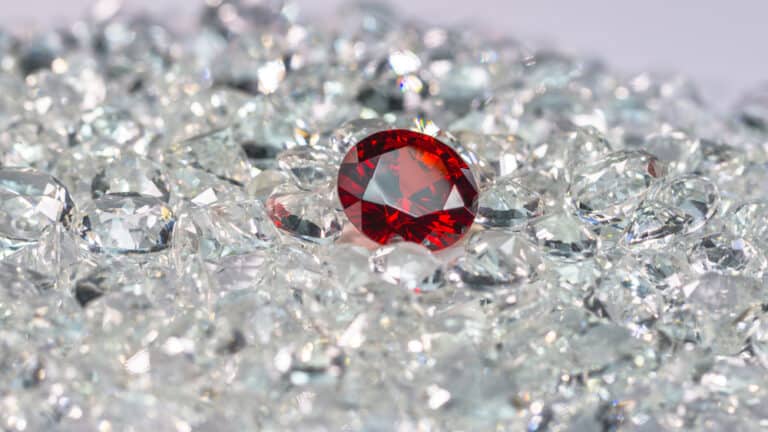People, much like magpies, are attracted to shiny objects. Gems, particularly diamonds, have become valuable and expensive jewelry. Diamonds also have a functional benefit in industry as their hardness allows them to be used in machinery. As you gaze at your diamond ring or the diamond point on the tip of your drill bit, you may wonder how diamonds were formed. Many people confidently assert that diamonds come from coal but is this true?
Diamonds do not come from coal. Coal forms over millions of years from compressed plant material. Diamonds are estimated to be a million or more years old and predate the existence of plants on earth. Coal comes from horizontal geological layers, and diamonds come from vertical pipes.
Some of the most captivating objects in nature have unpleasant or violent origins. Scenic mountains arose from the upheaval in the earth’s tectonic plates, and pearls develop from grit irritating an oyster. Diamonds are similarly born in dramatic and intense conditions. The Ancient Greeks believed the tears of the gods fell to earth as diamonds.
Do Diamonds Develop From Coal?
The theory that diamonds develop from coal has been circulating in urban legend and pseudoscience circles for a long time. It probably developed because diamonds and coal have the same basic element, carbon.
Coal is a sedimentary rock formed from carbons and hydrocarbons. Plant material in swampy forests or wetlands decays into peat. Peat can be seen in geological features, which we call moors, bogs, or fens. The peat was heated and compressed over millions of years, forming coal.
Due to how it developed, coal is found in horizontal strata in the earth’s structure. Some of these strata are extensive and may be called coal forests.
Diamonds also develop from carbon, but they do not use plant material as a source for carbon. One of the clues to this fact is that coal is always found in horizontal layers, such as you would see when plant material dies and falls to the earth.
Diamonds are always found in vertical layers known as pipes. Plant material would not be deposited in this manner, so diamonds must develop another way.
The second fact indicating that diamonds do not come from coal is their respective ages. Coal is millions of years old, whereas diamonds are hundreds of millions of years and even billions of years old. Diamonds were developed before plants were on earth, and they, therefore, cannot have developed from coal.
Thirdly, coal is a sedimentary rock. Diamonds are always found in igneous rock, conclusively disputing the fact that diamonds do not form from coal.
You can relax knowing that you are not wearing a piece of coal around your neck when donning your expensive diamond pendant.
How Do Diamonds Form?
No one, even the scientists, is quite sure where the carbon came from to form diamonds. A popular theory is that carbon was trapped underground during the earth’s formation, but its exact origin will remain shrouded by the mists of time.
Diamonds develop from carbon trapped in the earth’s mantle approximately 90 miles(150km) under the surface. The temperatures here are at least 2000°F (1050°C) and are critical for diamond formation.
The pressure on the carbon atoms in the mantle is 45 to 60 kilobars, equivalent to 50 000 times the earth’s atmospheric pressure. The extreme pressure and temperature alter the carbon forming crystals in a tetrahedral structure. Diamonds are the purest form of transparent solid carbon.
A diamond is described as having a tetrahedral structure as each molecule is three-dimensional with four surfaces. A central carbon atom is bound to four carbon atoms by covalent bonds.
Tetrahedral shapes are very rigid, making diamonds one of the hardest substances known to man. The hardness of diamonds is reflected in their name. The name diamond comes from the word Adamas which means unconquerable or indestructible in Greek.
The rigidity of the diamond structure prevents most substances from penetrating the formation to cause impurities.
This is contrasted with coal which contains many impurities, including fungi, bacteria, and plant debris. The impurities in coal would prevent any diamond development.
Nitrogen and boron are the only elements sometimes included in the carbon crystal formation of diamonds. These elements form inclusions or defects in the diamonds. Nitrogen gives diamonds a yellow tint, and boron gives them a blue color.
An interesting element in diamond development is that the formation of a diamond may not happen in one continuous process. If the surrounding conditions change, the diamond’s development can be arrested. When conditions are once more favorable, the diamond will continue to develop.
How Do Diamonds Get To The Earth’s Surface?
How do diamonds get to the surface if they are formed deep in the earth’s mantle?
Volcanic eruptions from deep in the earth transport diamonds up from the mantle. The lava cools rapidly and forms a pipe of igneous rock. There are two types of rock, kimberlite and lamproite. Kimberlite is the most common transporter of diamonds to the earth’s surface.
It is critical for the lava to cool rapidly for the diamonds to survive. If the heat continues too long, the diamonds will change to graphite. The lava from the kimberlite erupts onto the surface, and some diamonds may be expelled.
Diamonds are mined from the kimberlite or lamproite pipes. In some instances, erosion may have exposed the pipes, allowing the diamonds to be found loose on the earth’s surface.
Diamonds may also be formed when one tectonic plate subducts below another. The pressure and heat generated during these shifts cause the formation of diamonds. Later shifts in the tectonic plates may expose the diamonds.
Asteroids striking the earth’s surface produce a tremendous amount of heat and pressure. A typical speed for an asteroid is 9 to 12 miles per second.
The kinetic energy carried in the asteroid is greater than the simultaneous activation of several nuclear weapons. The pressure transfer is immense, and the heat generated would be much hotter than the sun. These conditions are ideal for the formation of diamonds.
Diamonds formed from asteroid strikes are found closer to the earth’s surface. Erosion of soil and rock over the years exposes the diamonds.
How Old Are Diamonds?
Natural diamonds are extremely old. They usually range between 1 to 3.5 billion years old. It is difficult to age diamonds precisely because they are made of a pure element, carbon. The only way to determine the age is by scientifically analyzing and testing the inclusions.
Is It Harder To Find Diamonds Or Coal?
Diamonds only develop at certain places in the earth’s mantle, which are stable enough to allow for the formation of diamonds. These sites are rare, making it difficult to find kimberlite pipes and diamonds.
Geologists usually estimate that it will take 10 years of searching to find a kimberlite pipe. Even after finding the kimberlite pipe, there is no guarantee that the pipe will contain diamonds or enough diamonds to be profitably mined.
Only 1 in every 200 kimberlite pipes found contains diamonds of gemstone quality. This contributes to the difficulty in finding diamonds and increases their rarity.
Coal is not as rare as diamonds. Coal develops from vegetation, which is more abundant, making coal more common than diamonds. Coal develops in areas just below the surface and therefore does not need to be transported vast distances through the earth. Coal is generally found within 2 miles of the surface.
Coal is a common substance that is used for energy production. It is a non-renewable resource as it takes millions of years to produce coal. Coal is being mined and used faster than new stores can be made.
Coal is also found by geologists through ground surveys and test mines.
Diamonds Can Be Made in Laboratories
In the 1950s, scientists began producing diamonds in laboratories. The methods used show conclusively that coal does not produce diamonds.
The first method for producing diamonds is known as HPHT – High-Pressure High Temperature. It mimicked the conditions that occurred in the earth when diamonds formed. A new technique is known as Chemical Vapor Deposition – CVD.
Both HPHT and CVD use a diamond seed to provide the ‘pattern’ for diamond development. Diamond seeds are tiny slices of a diamond, about as thick as human hair.
It takes approximately 28 days for a diamond to be produced in a laboratory. Diamonds made in laboratories can be produced without any flaws or inclusions.
The color of diamonds can also be manipulated by the inclusion of various elements. Although diamonds are grown in laboratory conditions, each one is still different.
These diamonds are preferred by people conscious of preserving the ecology and the earth’s natural state as there is no destruction through mining. Laboratory diamonds are cheaper per carat than natural diamonds and are just as beautiful.
Both diamond and coal mines destroy vast regions of land. The natural habitat of many organisms and wildlife is destroyed. The ground is deforested, and erosion is a pressing concern when mining ceases.

Conclusion
Diamonds are not made from coal. You can state with one hundred percent certainty that the myth of coal-producing diamonds is incorrect. Burning coal in your fireplace is never going to give you diamonds.
References
- https://en.wikipedia.org/wiki/Diamond
- https://www.smithsonianmag.com/science-nature/diamonds-unearthed-141629226/
- https://www.gia.edu/doc/SP91A1.pdf
- https://www.capetowndiamondmuseum.org/about-diamonds/formation-of-diamonds/
- https://sciencemadefun.net/blog/think-about-it-thursday-where-do-diamonds-come-from/
- https://geology.com/articles/diamonds-from-coal/
- https://en.wikipedia.org/wiki/Coal
- https://education.nationalgeographic.org/resource/coal
- https://www.diamondnexus.com/blog/how-diamonds-are-made/






